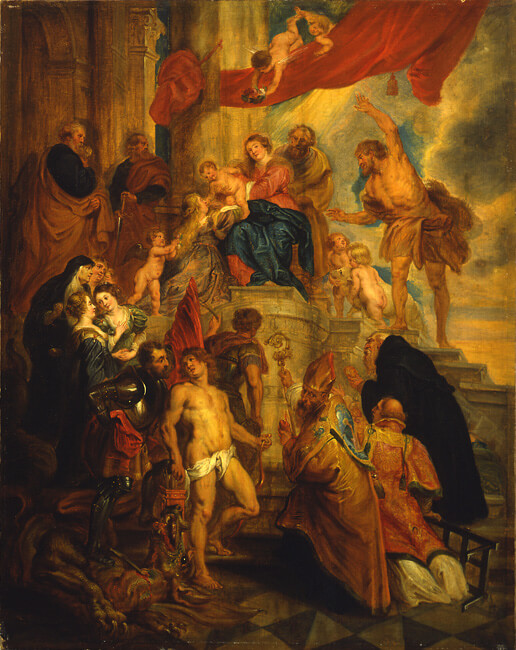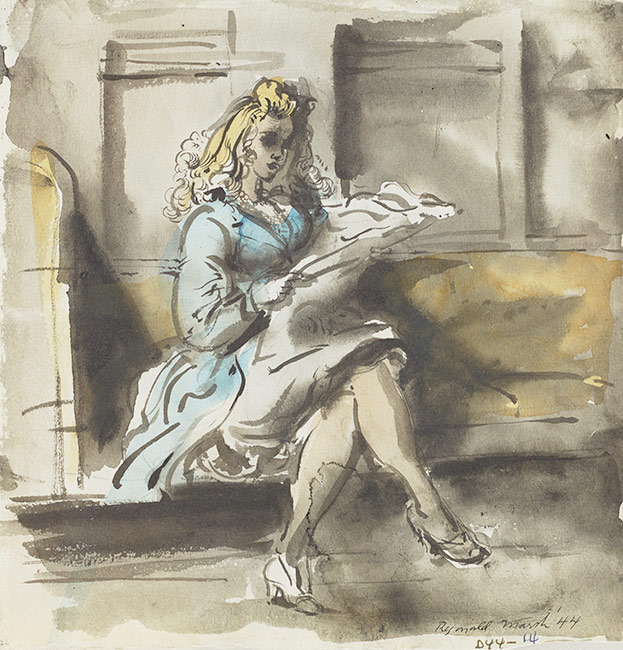In this blog series, I have tended to focus closely on American art. This is, of course, mostly by design: I am a specialist in art of the United States, and the project I’m working on is all about CFAM’s American collection. Even when I have written about American artists who immigrated to this country, including Wolf Kahn, Jean Charlot, and Tibor Pataky, or, alternately, artists like James Whistler, who spent their careers abroad, I have tended to focus on the aspects of their careers which intersect most closely with the history of American art. This focus has caused me to spend less time than I might on the close interrelations between European and American art and artists, and the ways in which Americans and Europeans have long influenced one another. This week, through my research on the American painter Reginald Marsh, I have had the occasion to rectify that oversight a bit. For, though he is known as the foremost chronicler of working-class popular culture in Depression-era New York, Marsh was very much indebted to the work of the European Old Masters.
Born in Paris to independently wealthy artists, Marsh moved back to the United States as a child, spending his formative years in New Jersey before attending Yale University.1 After Yale he moved to New York City, eventually taking a studio at 21 East 14th Street, overlooking Union Square. He thus became associated with the Fourteenth Street School, a group of painters who shared both a geographic location and a focus on the subject matter of urban life, in particular office workers, salesgirls, and busy shoppers.2 To represent this new urban world, Marsh turned to an unlikely source of inspiration: the paintings of the Old Masters of the Renaissance and Baroque periods. In fact, according to the curator and art historian Barbara Haskell, Marsh was obsessed with the Old Masters.3 This obsession took several forms, including his adoption of egg tempura for most of his paintings, his use of formal strategies associated with Peter Paul Rubens and other masters, and his fanatical drawing practice.4

Marsh’s debt to Rubens is well illustrated in his many scenes of Coney Island, such as Wonderland Circus, Sideshow Coney Island (1930, John and Mable Ringling Museum of Art), in which the forms of seaside revelers mass atop one another, forming a writhing, dynamic pyramid that ripples with robust corporeality. In CFAM’s The Virgin and Child Adored by Saints, by a follower of Rubens, we see a similar effect, with the Baroque master’s preference for thick muscular bodies on full display. This debt is also apparent, however, in A Young Woman Reading on the Subway, a late-career watercolor in the CFAM collection. Marsh, whose obsession with the Old Masters caused him to draw from the nude model nearly every day, believed that study of canonical paintings was even more important than drawing from life. He sincerely believed that the Old Masters were the be-all-and-end-all of depictions of human anatomy.5 One result of this belief was his development of something of an ideal female type, which has been called the “Marsh girl,” described by the art historian Erica Doss as “…typically big, tall, and busty, with carefully coiffed hair, lots of makeup, a haughty expression, and long, long legs.”6 This description fits A Young Woman Reading on the Subway to a T, and might also describe the two young women to the left of The Virgin and Child Adored by Saints, or perhaps even the Virgin herself.

Marsh was known to sketch everywhere he went, even sneaking sketchbooks into burlesque clubs where cameras and other recording devices were strictly forbidden. He also took photographs to aid his memory, including of people on the subway who were unaware they were being watched with such scrutiny.7 It seems likely that the young woman in the CFAM drawing was one such person. Marsh once described his approach to his art as “Go out into the street, stare at the people. Go into the subway. Stare at the people. Stare, stare, keep on staring.”8 Whatever this young woman might have thought of Marsh and his staring, her likeness stands as testament to his blending of a technical and formal reverence to the Old Masters with a careful, even maniacal, observation of everyday life in America’s largest city.
1 Barbara Haskell, “Swing Time: Reginald Marsh and the Exuberant Chaos of Modern Life,” in Swing Time: Reginald Marsh and Thirties New York ; [… a Companion Publication to the Exhibition Swing Time: Reginald Marsh and Thirties New York at the New-York Historical Society, June 21 – September 2, 2013], ed. Morris Dickstein et al. (Exhibition Swing Time: Reginald Marsh and Thirties New York, New York, NY: New-York Historical Society, 2012), 11–14.
2 Haskell, 15.
3 Haskell, 39.
4 On Marsh’s use of Old Master paint recipes, in particular for egg tempera, see Lance Mayer and Gay Myers, “Old Master Recipes in the 1920s, 1930s, and 1940s: Curry, Marsh, Doerner, and Maroger,” Journal of the American Institute for Conservation 41, no. 1 (2002): 21–42.
5 Haskell, “Swing Time: Reginald Marsh and the Exuberant Chaos of Modern Life,” 39.
6 Erika Doss, “‘Go Out into the Street, Stare at the People’: Reginald Marsh and Surveillance Styles in Interwar American Art,” in Swing Time: Reginald Marsh and Thirties New York ; [… a Companion Publication to the Exhibition Swing Time: Reginald Marsh and Thirties New York at the New-York Historical Society, June 21 – September 2, 2013], ed. Barbara Haskell et al. (Exhibition Swing Time: Reginald Marsh and Thirties New York, New York, NY: New-York Historical Society, 2012), 115.
7 Doss, 124.
8 Quoted in Doss, 111.

